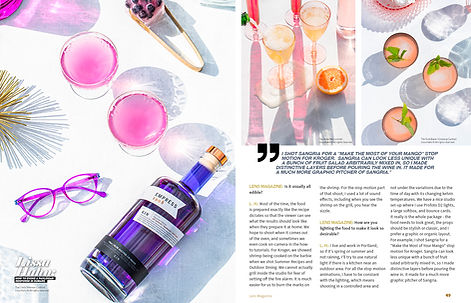VIEW STYLE
Advertising & Stop Motion Photography

HOW TO EVOKE A PAVLOVIAN RESPONSE IN HUMANS
AN EXCLUSIVE INTERVIEW WITH LISSA HAHN BY MARK EDWARD HARRIS
Bay Area-based photographer Lissa Hahn specializes in food advertising, lifestyle, and stop motion photography supporting the culinary professional with over 20 years of experience. She has built a reputation for producing consistently clean and classic images working with agencies, chefs, cooking schools, and restaurants, as well as creating imagery for cookbooks. Hahn's extensive knowledge in the industry and a keen eye for styling combine to create strong visual content for her clients while staying true to each company's visual branding.


The main purpose of food photography is to entice the viewer of the imagery into buying the product, whether it was commissioned for a supermarket advertisement or a cooking school menu.
But how does a photographer create that desired result from the food items and dishes in front of their lens? Bay Area-based Lissa Hahn illustrates how she uses both traditional stills and stop-motion photography to create mouthwatering responses and successful projects and campaigns for her clients.
LENS MAGAZINE:
It's a pleasure interviewing you, Lissa. You have a unique artistic style in a special photography field. What do you and your clients aim to achieve with your food photography, and how do you reach those goals?
LISSA HAHN:
Thank you, Mark. We try to show how easy it is to make something fresh and nutritious. We often include tips and tricks in the stop-motion animations that we do. For example, in my recent shoots for Kroger, we feature products that the viewer can purchase so they can make things from scratch at home, like homemade pizza or things they can make in an air fryer. For the most recent stop motion I did, we showed how to prepare and cook lobster for a romantic Valentine's Day Surf and Turf dinner. Our main goal is to inspire people to cook at home.


LENS MAGAZINE: Do you work with a stylist?
LISSA: A food stylist is vital unless I'm shooting for a chef who is then prepping and plating the food. Either way, I'm always collaborating with them to create the final look of the dish. I do a lot of research so that the final platting is unique or upleveled from what one might do at home, so it is inspiring. I also am very involved in getting the right props secured for the shot. I often go shopping myself to ensure I get what we need. Food photography is a collaborative effort. When I direct a stop motion video for Kroger, the food stylist might also become the hand talent, or we might bring in hand talent.
LENS MAGAZINE: There was a great episode of "Seinfeld" where George was cast as a hand model. In your business, it's a serious consideration.
LISSA: It is, but in our case, the trick to hand talent is finding a chef with good-looking hands. It's not enough that the person we bring in has nice-looking hands. It's imperative to have somebody on camera who knows how to cook because even though it sounds easy, certain things need to be done professionally, such as chopping vegetables. You don't want to demonstrate how to chop vegetables in a dangerous way.
LENS MAGAZINE: How are the items and dishes for food photography prepared?
LISSA: In some cases, the food stylist will do some test cooking the day before to mock up and ensure that the recipes work. All the food is then made fresh the day of the shoot, so it's camera ready. It's best to shoot it when it comes out of the oven, off the stovetop, or when it's freshly prepared. I set up the shot in advance with a "stand-in" so when the dish comes out, I can shoot it right away; otherwise, the food can become deflated, too greasy, or melted. For instance, when we shoot chocolate bark, the chocolate hardens within five minutes, so we must act fast. Avocado is super hard to work with. There is a certain agent, ascorbic acid, that you must mix into guacamole to prevent it from becoming dark green as you shoot. It still happens but just not as fast. For example, our Super Bowl Snack Stadium shoot had guacamole dip as a football field. The football players were made out of tomatoes–one team was made of red cherry tomatoes, and the other team members were made of yellow cherry tomatoes. The lines of the field were made with sour cream, the end zones were made out of salsa, and the guacamole was the field itself. The whole stop- motion video took all day, so you can imagine how fast we had to work. The keys to shooting food are not only styling and lighting but timing as well.
LENS MAGAZINE: Is it usually all edible?
LISSA: Most of the time, the food is prepared exactly like the recipe dictates so that the viewer can see what the results should look like when they prepare it at home. We hope to shoot when it comes out of the oven, and sometimes we even cook on-camera in the how- to tutorials. For Kroger, we showed shrimp being cooked on the barbie when we shot Summer Recipes and Outdoor Dining. We cannot actually grill inside the studio for fear of setting off the fire alarm. It is much easier for us to burn the marks on the shrimp. For the stop motion part of that shoot, I used a lot of sound effects, including when you see the shrimp on the grill, you hear the sizzle.
LENS MAGAZINE: How are you lighting the food to make it look so desirable?
LISSA: I live and work in Portland, so if it's spring or summer and not raining, I'll try to use natural light if there is a kitchen near an outdoor area. For all the stop motion animations, I have to be constant with the lighting, which means shooting in a controlled area and not under the variations due to the time of day with its changing kelvin temperatures. We have a nice studio set-up where I use Profoto D2 lights, a large softbox, and bounce cards. It really is the whole package - the food needs to look great, the props should be stylish or classic, and I prefer a graphic or organic layout. For example, I shot Sangria for a "Make the Most of Your Mango" stop motion for Kroger. Sangria can look less unique with a bunch of fruit salad arbitrarily mixed in, so I made distinctive layers before pouring the wine in. It made for a much more graphic pitcher of Sangria.


LENS MAGAZINE: What camera and lenses are you using to capture these creations?
LISSA: I typically shoot with the 5D Mark IV. When my camera is rigged from above, I shoot with the Canon EF 24-70mm f/4.0L USM lens, which has a lock on the lens. It is so helpful to have that lock; otherwise, the lens tends to continually zoom to 70mm when hanging. When I come in for tight shots, I typically use the Canon EF 100mm f/2.8L Macro USM lens. The texture of the food gives an intimate feeling. I tend to shoot with a shallow depth of field because we want texture and then for the background to fall off. We want the hero of the image to stand out. If you can taste that chicken wing being dipped, we've succeeded. You can almost imagine the smell and taste; it's practically in your hands. I admit I get hungry when I'm editing.
LENS MAGAZINE: When did you start incorporating moving images into your work? It's hard to not get hungry when looking at those.
LISSA: About 15 years ago, when photographers were getting into video, I explored it as well but found it more interesting to make moving pictures. Stop motion allows me to tell more of a story. I love that. I've been a photographer for over twenty years, and in the past, I shot fashion, portraiture, advertising, and fine art until I decided to specialize in food photography.
Making food look appetizing is difficult, and I like the challenge. Stop-motion food photography is even more challenging because the food gives an intimate feeling. I tend to shoot with a shallow depth of field because we want texture and then for the background to fall off. We want the hero of the image to stand out. If you can taste that chicken wing being dipped, we've succeeded. You can almost imagine the smell and taste; it's practically in your hands. I admit I get hungry when I'm editing. food is on-camera for a lot longer than one shot. I like to tell a story, but I also love to play with shapes and make colorful graphic compositions.
LENS MAGAZINE: How are you creating GIFs, and how are they used?
LISSA: I create GIFs in Photoshop, putting them on a timeline and choosing the rate cycle. I take three to ten images and create a GIF to keep the files a reasonable size. Many end up on Pinterest. The stop motion videos are for website experience. I do a lot of holiday-themed stop-motion animations, which get featured on the Kroger holiday splash page.
Because of the stop motion component, we end up shooting 800 to 1500 pictures in about 10 hours.
I do all the still editing and organization in Lightroom, then transfer my edits for the stop motion to a timeline. The video turns out to be about one and a half to two and a half minutes.
My favorite part of editing is after adding the music, I can really tweak the motions to hit the beats and rhythms. It's like a little dance. Here's one situation where I think it's okay to play with your food!












